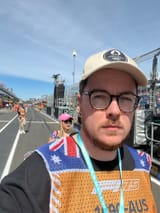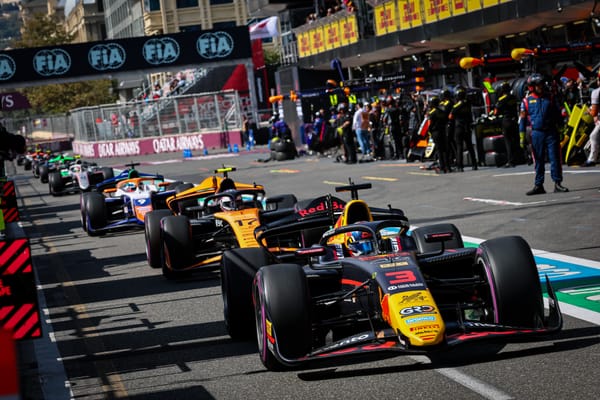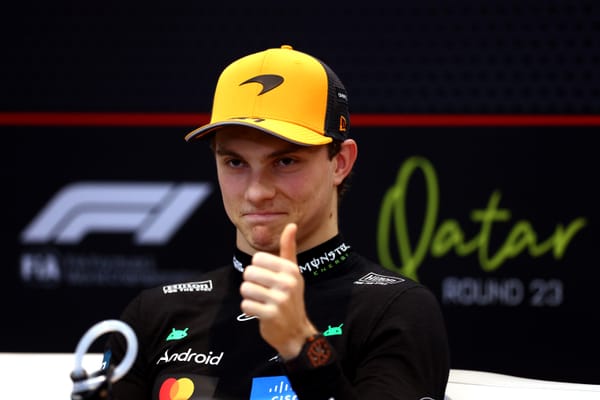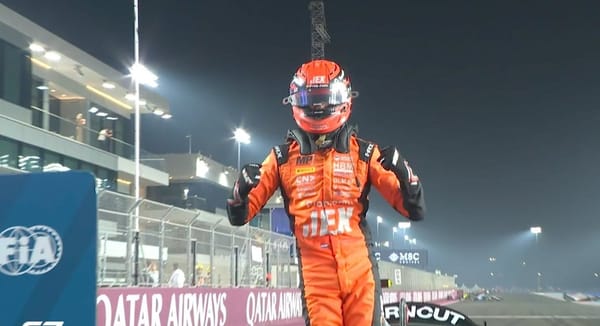Pirelli tyre safety issues could lead to mandatory three-stop Qatar Grand Prix

Formula One drivers were given an extra practice session and the sprint shootout was delayed on Saturday in Qatar as tyre manufacturer Pirelli raised safety concerns over the newly-resurfaced circuit.

Mario Isola, motorsport director at Pirelli, addresses the media on Saturday in Qatar. (Pirelli)
The FIA also suggested that three pit stops could be mandated for Sunday’s Grand Prix.
Formula 1 and Pirelli each said that tyre issues were revealed in regular safety tests which take place the Friday night before each grand prix, after Pirelli had previously said that tyre data was limited on the new track surface and with windy and sandy conditions.
“During our usual analysis last night after free practice, we discovered that some tyres that had done 20 or more laps were showing signs of micro lacerations in the sidewall, between the topping compound and the carcass cords, most likely caused by the impact generated by repeatedly going over the kerbs at some corners, especially turns 12 and 13,” said Mario Isola, motorsport director at the Italian tyre manufacturer.
“We immediately informed the FIA, who proceeded to take action, by revising the track limits at these corners and instigating an additional free practice session prior to the sprint shootout, to allow the drivers to check out the new lines through this part of the track.”

Pirelli tyres prepared for McLaren in the Qatar Grand Prix. (Pirelli)
The track limits at turns 12 and 13 were adjusted, with an additional ten-minute practice session before the sprint shootout for drivers to familiarise themselves with the changed layout.
Pirelli is analysing tyres used in the sprint race to determine if further action needs to be taken for Sunday’s grand prix, with the FIA suggesting that three pit stops could be mandated for the race.
“It is the view of the FIA and Pirelli that a significant number of additional laps on these tyres could result in circumferential damage of the tyres with subsequent air loss, and tyres analysed with lower lap numbers showed a much-reduced extent of the issue,” read part of the statement from the FIA.
“This issue has likely been caused by the high-frequency interference between the tyre sidewall and the 50mm ‘pyramid’ kerbs used extensively at this circuit, aggravated by the propensity to ride those kerbs.”
“In the event the problem is still evident, we will be issuing the following directive for Sunday’s Grand Prix, on safety grounds: a) The tyre life parameter must not exceed 20 for new tyres used in the race. This number would rise to 22 for any used tyres fitted in the race, to account for in-out laps in qualifying. b) All drivers will be obliged to perform at least three tyre-change pitstops during the race.”

Pirelli signage in Qatar. (Pirelli)
The tyre issues follow repeated statements from Pirelli regarding a lack of available tyre data at the Lusail circuit, with chief engineer Simone Berra commenting on Friday that “wind, sand and a brand-new surface: this combination made it very difficult to decipher the first day at the Lusail circuit.”
“The conditions were predictable, but they certainly made life more complicated for everyone because very little of the acquired data was useful to prepare for the rest of the weekend.”
“That is even more the case for ourselves, because with only 60 minutes of free practice there was very little time for long runs, with few laps completed and few drivers attempting it.”
The issue rears its head for the second time in Qatar, with four drivers suffering tyre failures during the inaugural event at the circuit in 2021.
Isola told Sky Sports in 2021 that the issues could have been due to heavy wear on the kerbs as well as teams running longer stints than recommended.
“The tyres were quite worn, close to 100%,” said Isola.
“We have cuts on the tyres that we have to understand if they were caused before the loss of pressure or after the loss of pressure.”
“We’re waiting for telemetry data from the teams.”
"That is a really important element to understand if the loss of pressure was sudden and [what] was the time for that. All the drivers were able to go back to the pits, so they lost pressure but in a time that was enough to control the car and to go back to the pits.”
“We’re seeing a lot of impacts at high speed on the kerbs here.”
“It’s not a secret that [many teams] had also damage to chassis, to the floor, to the wings, and when a tyre is worn, it’s less protected from kerbs, big impacts, high-energy impacts. Then it can happen that they start losing pressure, and you have either to change the tyre or you’re flat.”
“For sure, we had a few teams trying a one-stop strategy, because here it’s difficult to overtake, they didn’t want to lose time in the pit.
“But the reason why we predicted a two-stop strategy was mainly because of the data on tyre wear that we collected on Friday, and the wear on the front-left was quite high. So today for example, the front-left and the rear-left were both worn to 100%. But the reason why we had a puncture on just the front-left has to be investigated.”
Watch Every Session of the 2023 Formula One World Championship live on Kayo Sports. Join today!





